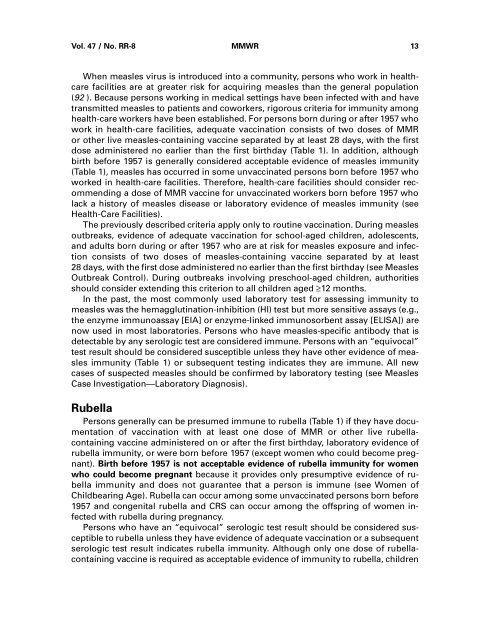Measles, Mumps, and Rubella - Centers for Disease Control and ...
Measles, Mumps, and Rubella - Centers for Disease Control and ...
Measles, Mumps, and Rubella - Centers for Disease Control and ...
You also want an ePaper? Increase the reach of your titles
YUMPU automatically turns print PDFs into web optimized ePapers that Google loves.
Vol. 47 / No. RR-8 MMWR 13When measles virus is introduced into a community, persons who work in healthcarefacilities are at greater risk <strong>for</strong> acquiring measles than the general population(92 ). Because persons working in medical settings have been infected with <strong>and</strong> havetransmitted measles to patients <strong>and</strong> coworkers, rigorous criteria <strong>for</strong> immunity amonghealth-care workers have been established. For persons born during or after 1957 whowork in health-care facilities, adequate vaccination consists of two doses of MMRor other live measles-containing vaccine separated by at least 28 days, with the firstdose administered no earlier than the first birthday (Table 1). In addition, althoughbirth be<strong>for</strong>e 1957 is generally considered acceptable evidence of measles immunity(Table 1), measles has occurred in some unvaccinated persons born be<strong>for</strong>e 1957 whoworked in health-care facilities. There<strong>for</strong>e, health-care facilities should consider recommendinga dose of MMR vaccine <strong>for</strong> unvaccinated workers born be<strong>for</strong>e 1957 wholack a history of measles disease or laboratory evidence of measles immunity (seeHealth-Care Facilities).The previously described criteria apply only to routine vaccination. During measlesoutbreaks, evidence of adequate vaccination <strong>for</strong> school-aged children, adolescents,<strong>and</strong> adults born during or after 1957 who are at risk <strong>for</strong> measles exposure <strong>and</strong> infectionconsists of two doses of measles-containing vaccine separated by at least28 days, with the first dose administered no earlier than the first birthday (see <strong>Measles</strong>Outbreak <strong>Control</strong>). During outbreaks involving preschool-aged children, authoritiesshould consider extending this criterion to all children aged ≥12 months.In the past, the most commonly used laboratory test <strong>for</strong> assessing immunity tomeasles was the hemagglutination-inhibition (HI) test but more sensitive assays (e.g.,the enzyme immunoassay [EIA] or enzyme-linked immunosorbent assay [ELISA]) arenow used in most laboratories. Persons who have measles-specific antibody that isdetectable by any serologic test are considered immune. Persons with an “equivocal”test result should be considered susceptible unless they have other evidence of measlesimmunity (Table 1) or subsequent testing indicates they are immune. All newcases of suspected measles should be confirmed by laboratory testing (see <strong>Measles</strong>Case Investigation—Laboratory Diagnosis).<strong>Rubella</strong>Persons generally can be presumed immune to rubella (Table 1) if they have documentationof vaccination with at least one dose of MMR or other live rubellacontainingvaccine administered on or after the first birthday, laboratory evidence ofrubella immunity, or were born be<strong>for</strong>e 1957 (except women who could become pregnant).Birth be<strong>for</strong>e 1957 is not acceptable evidence of rubella immunity <strong>for</strong> womenwho could become pregnant because it provides only presumptive evidence of rubellaimmunity <strong>and</strong> does not guarantee that a person is immune (see Women ofChildbearing Age). <strong>Rubella</strong> can occur among some unvaccinated persons born be<strong>for</strong>e1957 <strong>and</strong> congenital rubella <strong>and</strong> CRS can occur among the offspring of women infectedwith rubella during pregnancy.Persons who have an “equivocal” serologic test result should be considered susceptibleto rubella unless they have evidence of adequate vaccination or a subsequentserologic test result indicates rubella immunity. Although only one dose of rubellacontainingvaccine is required as acceptable evidence of immunity to rubella, children
















